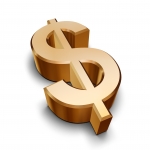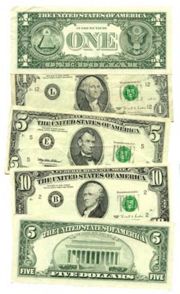USD发表评论(0)编辑词条
The United States dollar (sign: $; code: USD) is the unit of
currency of the United States The U.S. dollar is normally abbreviated as the dollar sign, $, or as USD or US$ to distinguish it from other dollar-denominated currencies and from others that use the $ symbol. It is divided into 100 cents (200 half-cents prior to 1857).
The U.S. dollar is the currency most used in international transactions. Although U.S. dollar is a fiat currency, several countries use it as their official currency, and in many others it is the de facto currency.
Overview
The U.S. dollar bill uses the decimal system, consisting of 100 equal cents (symbol ¢). In another division, there are 1,000 mills or ten dimes to a dollar, or 4 quarters to a dollar. However, only cents are in everyday use as divisions of the dollar; "dime" is used solely as the name of the coin with the value of 10¢, while "eagle" and "mill" are largely unknown to the general public, though mills are sometimes used in matters of tax levies and gasoline prices. When currently issued in circulating form, denominations equal to or less than a dollar are emitted as U.S. coins while denominations equal to or greater than a dollar are emitted as Federal Reserve notes (with the exception of gold, silver and platinum coins valued up to $100 as legal tender, but worth far more as bullion). Both one-dollar coins and notes are produced today, although the note form is significantly more common. In the past, "paper money" was occasionally issued in denominations less than a dollar (fractional currency) and gold coins were issued for circulation up to the value of $20 (known as the "double eagle," discontinued in the 1930s). The term eagle was used in the Coinage Act of 1792 for the denomination of ten dollars, and subsequently was used in naming gold coins. In 1854, James Guthrie, then Secretary of the Treasury, proposed creating $100, $50 and $25 gold coins, which were referred to as a "Union," "Half Union," and "Quarter Union," thus implying a denomination of 1 Union = $100.
Today, USD notes are made from cotton fiber paper, unlike most common paper, which is made of wood fiber.
Series of 1917 $1 United States Note
U.S. coins are produced by the United States Mint. U.S. dollar banknotes are printed by the Bureau of Engraving and Printing, and, since 1914, have been issued by the Federal Reserve. The "large-sized notes" issued before 1928 measured 7.42 inches (188 mm) by 3.125 inches (79.4 mm); small-sized notes, introduced that year, measure 6.14 inches (156 mm) by 2.61 inches (66 mm) by 0.0043 inches (0.11 mm).
Etymology
The name Thaler (from German thal, or nowadays usually Tal, "valley", cognate with "dale" in English) came from the German coin Guldengroschen ("great guilder", being of silver but equal in value to a gold guilder), minted from the silver from a rich mine at Joachimsthal (St. Joachim's Valley, now Jáchymov) in Bohemia (then part of the Holy Roman Empire, now part of the Czech Republic).
Dollar sign
The symbol $, usually written before the numerical amount, is used for the U.S. dollar (as well as for many other currencies). The sign's ultimate origins are not certain, though it is possible that it comes from the symbol for the New Spanish (Mexican) peso which in turn comes from the Spanish Coat of arms. This takes the form of two vertical bars and a swinging cloth band in the shape of an "S". An equally accepted, and better documented, explanation is that it is this symbol for peso was the result of a late eighteenth-century evolution of the scribal abbreviation "ps." The p and the s eventually came to be written over each other giving rise to $.
Coins
Official United States coins have been produced every day from 1792 to the present. In normal circulation today, there are coins of the denominations 1¢ ([one] cent, also referred to as a penny), 5¢ (nickel), 10¢ (dime), 25¢ (quarter dollar officially, or simply quarter in common usage), 50¢ (half dollar officially, sometimes referred to as a fifty-cent piece), and $1 (dollar officially, but frequently referred to as a dollar coin).
Banknotes
The United States dollar is unique in that there have been more than 10 types of banknotes, such as Federal Reserve Bank Note, gold certificate, and United States Note. The Federal Reserve Note is the only type that remains in circulation since the 1970s.
The largest denominations of currency currently printed or minted by the United States are the $100 bill and the $100 one troy ounce Platinum Eagle.
Currently printed denominations are $1, $2, $5, $10, $20, $50, and $100. Notes above the $100 denomination ceased being printed in 1946 and were officially withdrawn from circulation in 1969. These notes were used primarily in inter-bank transactions or by organized crime; it was the latter usage that prompted President Richard Nixon to issue an executive order in 1969 halting their use. With the advent of electronic banking, they became less necessary. Notes in denominations of $500, $1,000, $5,000, $10,000, and $100,000 were all produced at one time; see large denomination bills in U.S. currency for details.
美元(United States Dollar),又称美圆、美金,是美国的官方货币。它的出现是由于1792年美国铸币法案的通过。它同时也作为储备货币在美国以外的国家广泛使用。当前美元的发行是由美国联邦储备系统控制。最常用的表示美元的符号是“$”,而用来表示美分的标志是“¢”。国际标准化组织为美元取的ISO 4217标准代号为USD。
概要
一美元分为100美分。开始的时候更细的划分是密尔(mill),一美元分为1000密尔,这个单位现在已经不再使用了。美元的发行权属于美国财政部,主管部门是美国国库,办具体发行业务的是美国联邦准备理事会。从1929年起,美元钞票的印制由彫刻与印刷局来进行,而硬币是由美国铸币厂所铸造。目前流通的纸币面额有100、50、20、10、5、2、1元等7种,另有1元和50、25、10、5和1分铸币。历史上还曾经发行过500、1000甚至10000美元面额的钞票。其中10000美元并不在公众中流通,它是用于联邦储备银行与美国财政部之间进行财务交易。
纸币
美元纸币是采用棉纤维和麻制成的。棉纤维长使纸张不易断裂,吸墨好、不易掉色。麻纤维结实坚韧,使纸张挺括,经久流通不起毛,对水、油及一些化学物质有一定的抵抗能力。美元纸张中没有添加增白剂,呈本白色,在紫光灯下不反光。自1880年起,美钞纸张内夹有红蓝纤维丝,这种纤维丝是在造纸时掺入纸浆的。因此,纤维丝有的夹在纸中,有的浮于表面,用针尖可以把纤维丝挑出来。1928年以前,红兰纤维丝分布在钞票的正中,由上至下狭长的一条。1928年及以后各版,纤维丝漫布全版。1990年起,美元纸张中(人像左侧)加入了一条被称为“迈拉”的聚酯类高分子物质制成的安全线,安全线上有美元符号及面额数字,迎光透视清晰可见。 美元正面油墨为黑色稍深,略带灰色,背面为绿色。1934年以后各版,油墨中添加了磁物质,具有磁性真美钞采用荧光油墨和磁性油墨等专用油墨特制,故美钞正面右侧的绿色徽记和绿色号码,在白纸上用力擦拭后,纸上能留下“绿痕”。1996年以后发行的部分美元会随光线角度不同而显示一会黑一会绿。美元的主要图案是雕刻凹版印刷,库印及连号等为凸印。1990年版以后,下面肖像窗周围加有缩微文字。
硬币
美国流通硬币共有1分、5分、10分、25分、半元、1元6种面额,美国历史上曾有6位著名总统的头像分别出现在这6种面额的硬币上。1美分图案是美国历史上广为人知的林肯总统侧面头像,是林肯诞辰100周年(1909年)开始发行的;5美分图案是为纪念美国第三任总统,即美国《独立宣言》起草人杰斐逊离任回归故居130周年(1938年)发行的;10美分图案是实施“罗斯福新政”的罗斯福总统逝世一周年(1946年)时发行的;25美分是美国最常见的辅币,是美国开国总统华盛顿诞辰200周年时(1932年)发行的;半美元硬币原为美国自由女神像,目前所常见的是美国历史上最年轻的总统肯尼迪的头像,1963年,肯尼迪不幸遇刺身亡,为了纪念他,美国于1964年起改用肯尼迪头像作半美元的图案;1美元硬币有两种图案,一种是1961年发行的采用艾森豪威尔总统头像图案,由于此币外径太大(直径38.1毫米,俗称大美金1元),流通使用很不方便,因此,于1981年起重新发行小美金1元(直径为26.5毫米,比半美元外径还小些),图案换成美国女权运动活动家苏珊•安东尼的头像。1999年11月18日在费城造币厂首发了金黄色的美元1元硬币(昵称金色元golden dollar) 图像为印第安妇女“萨卡加韦”(Sacagawea)背负襁褓中的幼子“巴蒂斯特”(Jean Baptiste)。为了表彰美国原著民妇女及她们对美国的贡献。
暗记
在美元硬币上不那么显著的地方有一些用来表明其身份的暗记。在正面人的下方,会有一个大写字母来表示它是由哪家铸币厂制造的。其含义如下:
• P 弗拉德尔菲亚铸币厂(也就是费城造币厂)(PHILADELPHIA MINT)
• D 丹弗造铸厂(DENVER MINT)
• S 旧金山铸币厂(SAN FRANCISCO MINT)
• W 西点造铸厂(WEST POINT MINT)
通常所说的P版、D版美元等也就是不同铸币厂的版本,它们可能会在细节上有微小的出入。
与“USD,美元,货币”相关的词条
→如果您认为本词条还有待完善,请 编辑词条
词条内容仅供参考,如果您需要解决具体问题
(尤其在法律、医学等领域),建议您咨询相关领域专业人士。
0

同义词: 暂无同义词
关于本词条的评论 (共0条)发表评论>>










